CHEVROLET TRACKER 1997 Owners Manual
Manufacturer: CHEVROLET, Model Year: 1997, Model line: TRACKER, Model: CHEVROLET TRACKER 1997Pages: 388, PDF Size: 20.12 MB
Page 251 of 388
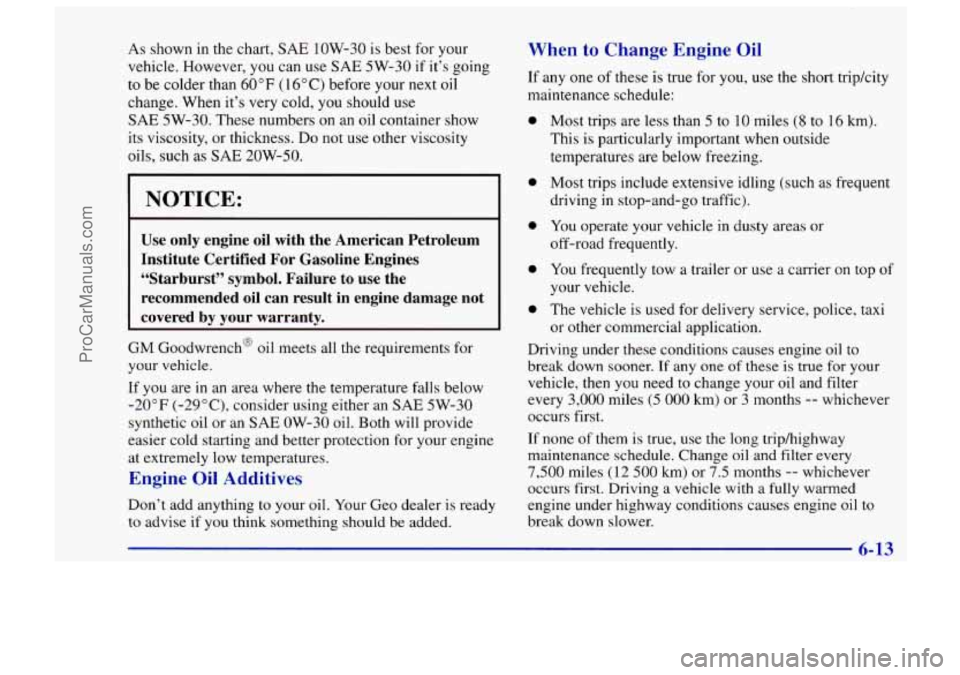
As shown in the chart, SAE 1OW-30 is best for your
vehicle. However, you can use
SAE 5W-30 if it’s going
to be colder than
60°F ( 16°C) before your next oil
change. When it’s very cold, you should use
SAE 5W-30. These numbers on an oil container show
its viscosity, or thickness.
Do not use other viscosity
oils, such as
SAE 20W-50.
NOTICE:
Use only engine oil with the American Petroleum
Institute Certified For Gasoline Engines
“Starburst’’ symbol. Failure to use the
recommended oil can result in engine damage not
covered
by your warranty.
GM Goodwrench’ oil meets all the requirements for
your vehicle.
If you are
in an area where the temperature falls below
-20°F (-29”C), consider using either an SAE 5W-30
synthetic oil or an
SAE OW-30 oil. Both will provide
easier cold starting and better protection for your engine
at extremely low temperatures.
Engine Oil Additives
Don’t add anything to your oil. Your Geo dealer is ready
to advise if you think something
should be added.
When to Change Engine Oil
If any one of these is true for you, use the short tripkity
maintenance schedule:
0
0
0
0
0
Most trips are less than 5 to 10 miles (8 to 16 km).
This is particularly important when outside
temperatures are below freezing.
Most trips include extensive idling (such as frequent
driving
in stop-and-go traffic).
You operate your vehicle in dusty areas or
off-road frequently.
You frequently tow a trailer or
use a carrier on top of
your vehicle.
The vehicle is used for delivery service, police, taxi
or other commercial application.
Driving under these conditions causes engine oil to
break down sooner. If any one
of these is true for your
vehicle, then you need to change your oil and filter
every
3,000 miles (5 000 km) or 3 months -- whichever
occurs first.
If none of them is true, use the long triphighway
maintenance schedule. Change oil and filter every
7,500 miles (12 500 km) or 7.5 months -- whichever
occurs first. Driving a vehicle with a
fully warmed
engine under highway conditions causes engine oil to
break down slower.
6-13
I
ProCarManuals.com
Page 252 of 388
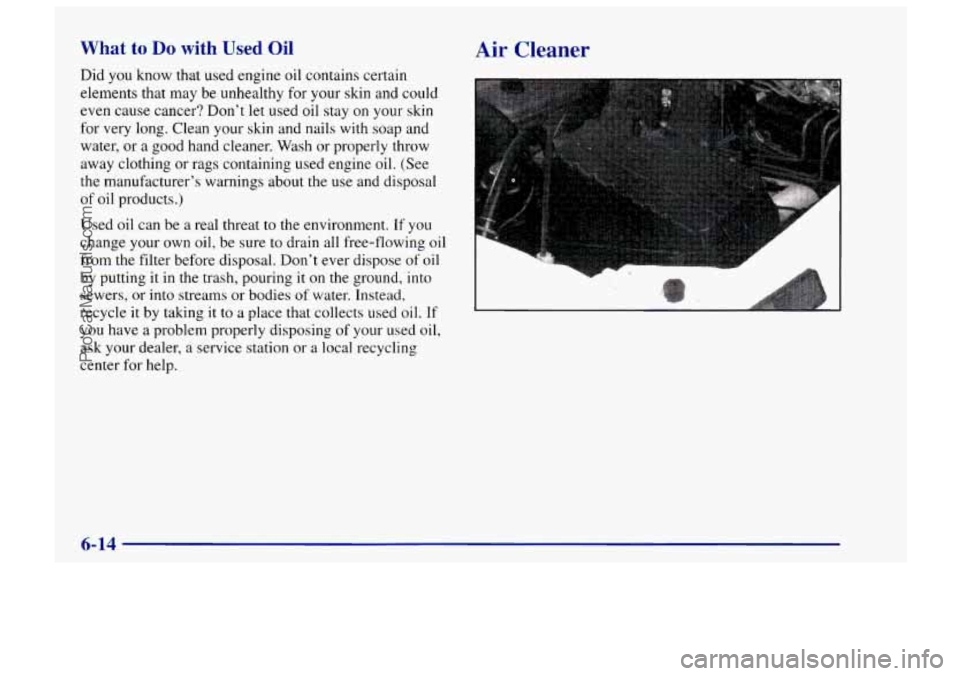
What to Do with Used Oil
Did you know that used engine oil contains certain
elements that may be unhealthy for your skin and could
even cause cancer? Don't let used oil stay on your skin
for very long. Clean your skin and nails with soap and
water, or a good hand cleaner. Wdsh or properly throw
away clothing or rags containing used engine oil. (See
the manufacturer's warnings about
the use and disposal
of oil products.)
Used oil can be a real threat to the environment.
If you
change your
own oil, be sure to drain all free-flowing oil
from the filter before disposal. Don't ever dispose
of oil
by putting it in the trash, pouring
it on the ground, into
sewers, or into streams or bodies of water. Instead,
recycle it by taking
it to a place that collects used oil. If
you have a problem properly disposing of your used oil,
ask your dealer,
a service station or a local recycling
center for help.
Air Cleaner
6-14
ProCarManuals.com
Page 253 of 388
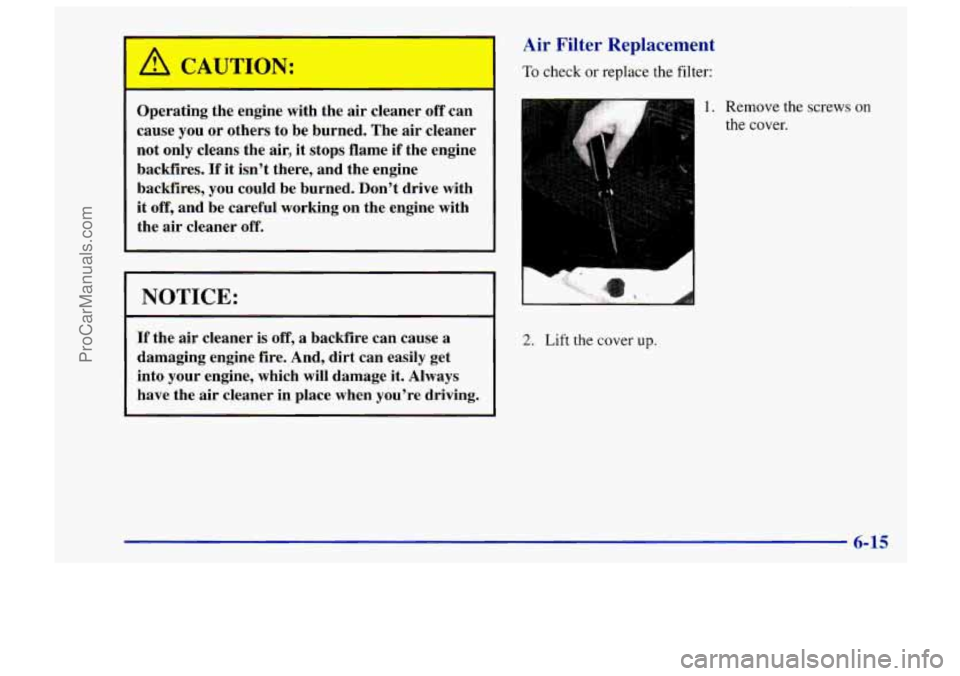
1 A CAUTION:
Operating the engine with the air cleaner off can
cause you or others to be burned. The air cleaner
not only cleans the air, it stops flame if the engine
backfires.
If it isn’t there, and the engine
backfires, you could be burned. Don’t drive with
it
off, and be careful working on the engine with
the air cleaner off.
I NOTICE:
If the air cleaner is off, a backfire can cause a
damaging engine fire. And, dirt can easily get
into your engine, which will damage
it. Always
have the air cleaner in place when you’re driving.
Air Filter Replacement
To check or replace the filter:
2. Lift the cover up.
1. Remove the screws on
the cover.
6-15
I
ProCarManuals.com
Page 254 of 388
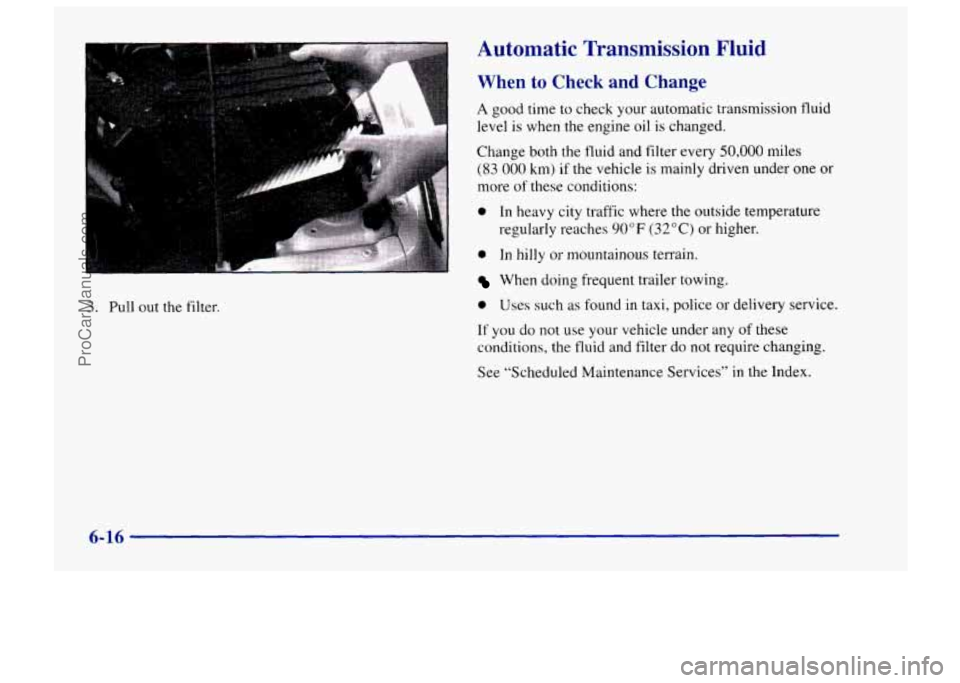
Automatic Transmission Fluid
When to Check and Change
A good time to check your automatic transmission fluid
level is when the engine oil
is changed.
Change both the fluid and filter every
50,000 miles
(83 000 km) if the vehicle is mainly driven under one or
more
of these conditions:
3. Pull out the filter.
0 In heavy city traffic where the outside temperature
regularly reaches
90°F (32°C) or higher.
0 In hilly or mountainous terrain.
When doing frequent trailer towing.
0 Uses such as found in taxi, police or delivery service.
If you do not use your vehicle under any of these
conditions, the fluid and filter do not require changing.
See “Scheduled Maintenance Services”
in the Index.
6-16
ProCarManuals.com
Page 255 of 388
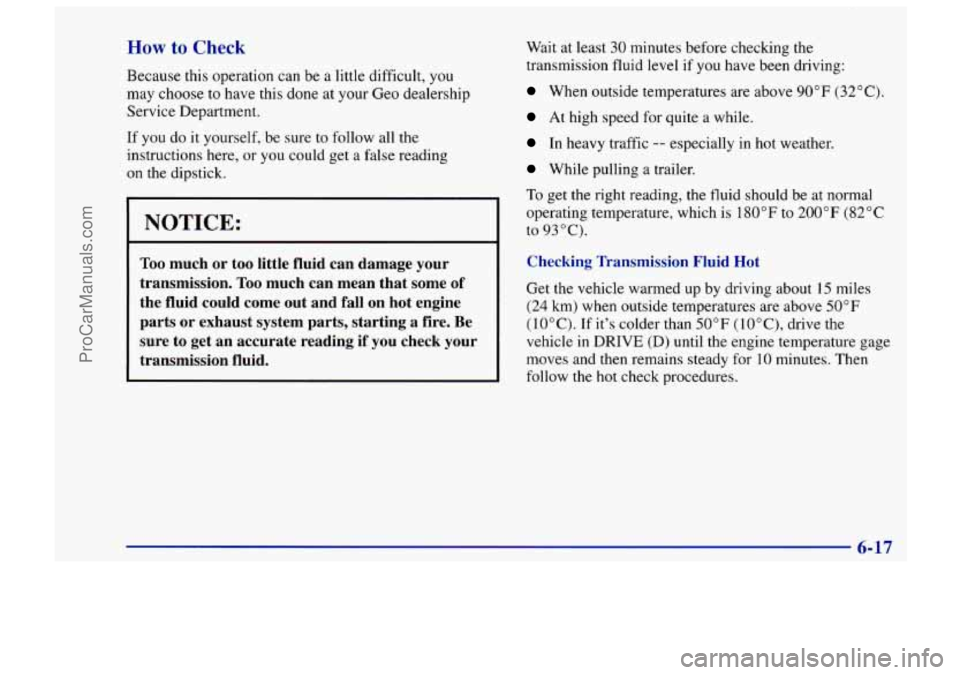
How to Check
Because this operation can be a little difficult, you
may choose to have this done at your Geo dealership
Service Department.
If you do it yourself, be sure to follow all the
instructions here, or you could get a false reading
on the dipstick.
I NOTICE:
Too much or too little fluid can damage your
transmission.
Too much can mean that some of
the fluid could come out and fall on hot engine
parts or exhaust system parts, starting a fire. Be
sure to get an accurate reading if
you check your
transmission fluid.
Wait at least 30 minutes before checking the
transmission fluid level if
you have been driving:
When outside temperatures are above 90°F (32°C).
At high speed for quite a while.
In heavy traffic -- especially in hot weather.
While pulling a trailer.
To get the right reading, the fluid should be at normal
operating temperature, which is
180°F to 200°F (82°C
to 93 "C).
Checking Transmission Fluid Hot
Get the vehicle warmed up by driving about 15 miles
(24 km) when outside temperatures are above 50°F
(10°C). If it's colder than 50°F (IOOC), drive the
vehicle
in DRIVE (D) until the engine temperature gage
moves and then remains steady for
10 minutes. Then
follow the hot check procedures.
6-17
I
ProCarManuals.com
Page 256 of 388
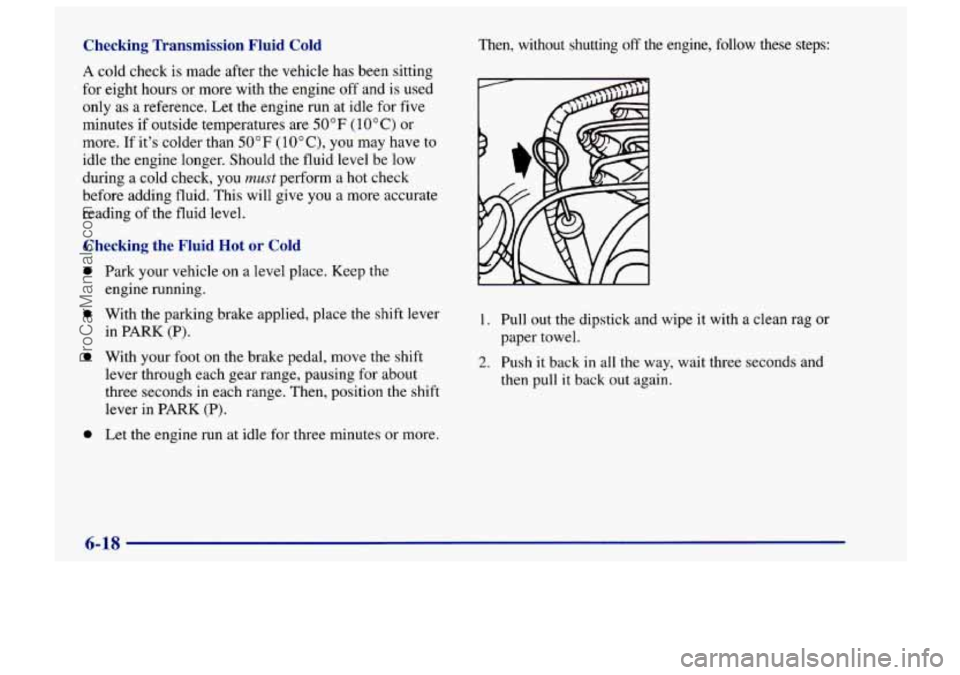
Checking Transmission Fluid Cold
A cold check is made after the vehicle has been sitting
for eight hours or more with the engine off and is used
only as a reference. Let the engine run at idle for five
minutes if outside temperatures are
50°F (10°C) or
more. If it's colder than
50°F (lO"C), you may have to
idle the engine longer. Should the fluid level be low
during a cold check, you
must perform a hot check
before adding fluid. This will give you a more accurate
reading of the fluid level.
Checking the Fluid Hot or Cold
0
0
0
0
Park your vehicle on a level place. Keep the
engine running.
With the parking brake applied, place the shift lever
in
PARK (P).
With your foot on the brake pedal, move the shift
lever through each gear range, pausing for about
three seconds in each range. Then, position the shift
lever in
PARK (P).
Let the engine run at idle for three minutes or more. Then, without shutting
off the engine, follow these steps:
1. Pull
out the dipstick and wipe it with a clean rag or
2. Push it back in all the way, wait three seconds and
paper
towel.
then pull it back out again.
6-18
ProCarManuals.com
Page 257 of 388
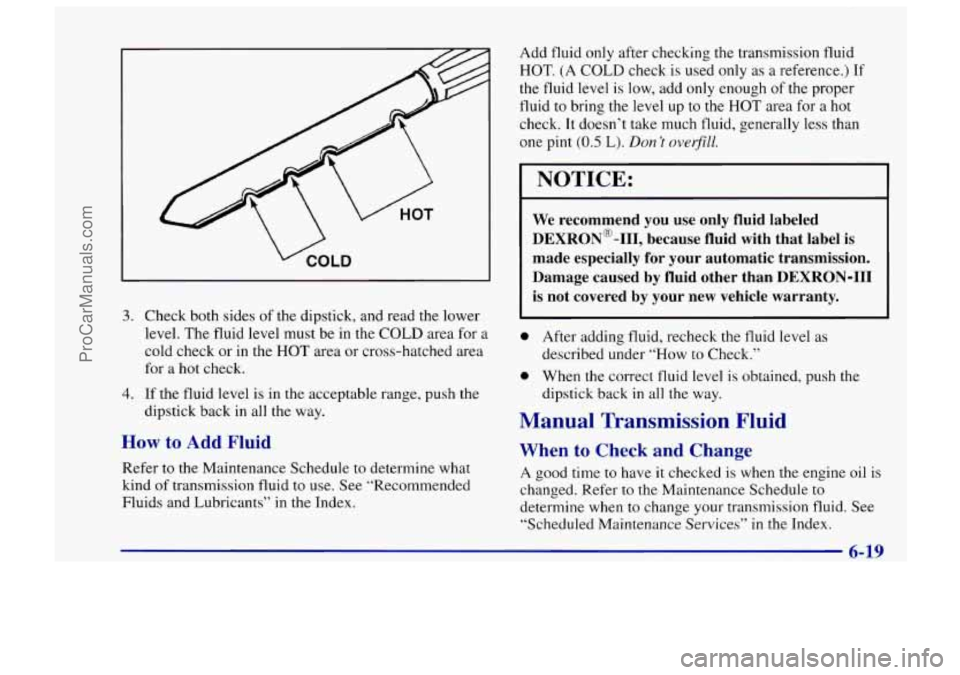
3. Check both sides of the dipstick, and read the lower
level. The fluid level must be
in the COLD area for a
cold check or
in the HOT area or cross-hatched area
for a hot check.
4. If the fluid level is in the acceptable range, push the
dipstick back in all the way.
How to Add Fluid
Refer to the Maintenance Schedule to determine what
kind
of transmission fluid to use. See “Recommended
Fluids and Lubricants” in the Index. Add
fluid only after checking the transmission fluid
HOT. (A COLD check
is used only as a reference.) If
the fluid level is low, add only enough of the proper
fluid to bring the level up to the HOT area for a hot
check.
It doesn’t take much fluid, generally less than
one pint
(0.5 L). Don ’I ove$iZZ.
NOTICE:
We recommend you use only fluid labeled
DEXRON@-111, because fluid with that label is
made especially for your automatic transmission.
Damage caused by fluid other than DEXRON-I11
is not covered by your new vehicle warranty.
0 After adding fluid, recheck the fluid level as
0 When the correct fluid level is obtained, push the
described under
“How to Check.”
dipstick back
in all the way.
Manual Transmission Fluid
When to Check and Change
A good time to have it checked is when the engine oil is
changed. Refer
to the Maintenance Schedule to
determine when to change your transmission fluid. See
“Scheduled Maintenance Services”
in the Index.
6-19
1
ProCarManuals.com
Page 258 of 388
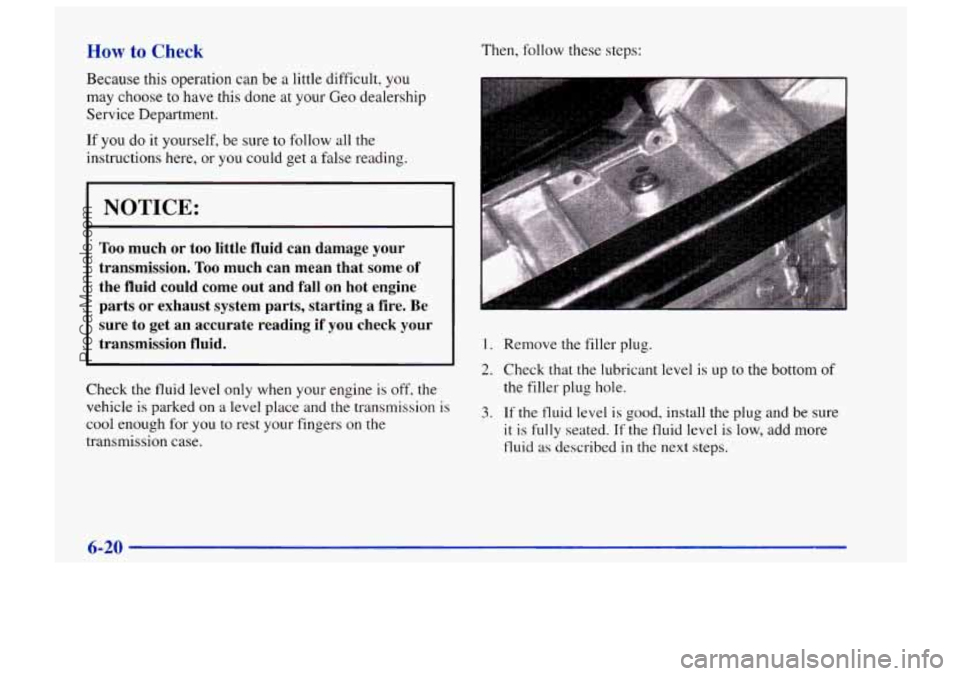
How to Check
Because this operation can be a little difficult, you
may choose to have this done at your Geo dealership
Service Department.
If you do it yourself, be sure to follow all the
instructions here, or you could get a false reading.
NOTICE:
Too much or too little fluid can damage your
transmission.
Too much can mean that some of
~ the fluid could come out and fall on hot engine
' parts or exhaust system parts, starting a fire. Be
~ sure to get an accurate reading if you check your
~ transmission fluid. ~
Check the fluid level only when your engine is off, the
vehicle is parked on
a level place and the transmission is
cool enough for you
to rest your fingers on the
transmission case. Then, follow these steps:
1. Remove the filler plug.
2. Check that the lubricant
level is up to the bottom of
the filler plug hole.
3. If the fluid level is good, install the plug and be sure
it is fully seated. If the fluid level is low, add more
fluid
as described in the next steps.
6-20
ProCarManuals.com
Page 259 of 388
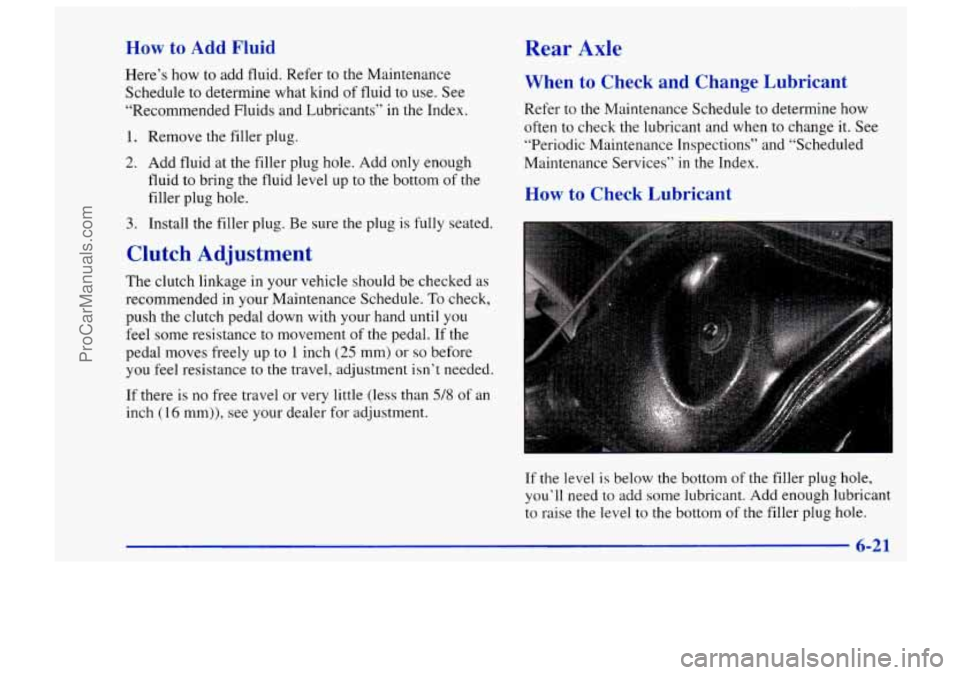
How to Add Fluid Rear Axle
Here’s how to add fluid. Refer to the Maintenance
Schedule
to determine what kind of fluid to use. See
“Recommended Fluids and Lubricants” in the Index.
1. Remove the filler plug.
2. Add fluid at the filler plug hole. Add only enough
fluid
to bring the fluid level up to the bottom of the
filler plug hole.
3. Install the filler plug. Be sure the plug is fully seated.
When to Check and Change Lubricant
Refer to the Maintenance Schedule to determine how
often to check the lubricant and when to change it. See
“Periodic Maintenance Inspections” and “Scheduled
Maintenance Services” in the Index.
How to Check Lubricant
Clutch Adjustment
The clutch linkage in your vehicle should be checked as
recommended in your Maintenance Schedule.
To check,
push the clutch pedal down with your hand until you
feel some resistance to movement of the pedal.
If the
pedal moves freely up to
1 inch (25 mm) or so before
you feel resistance to the travel, adjustment isn’t needed.
If there
is no free travel or very little (less than 5/8 of an
inch (16 mm)), see your dealer for adjustment.
If the level
is below the bottom of the filler plug hole,
you‘ll need to add some lubricant. Add enough lubricant
to raise the level to the bottom of the filler plug hole.
6-21
I
ProCarManuals.com
Page 260 of 388
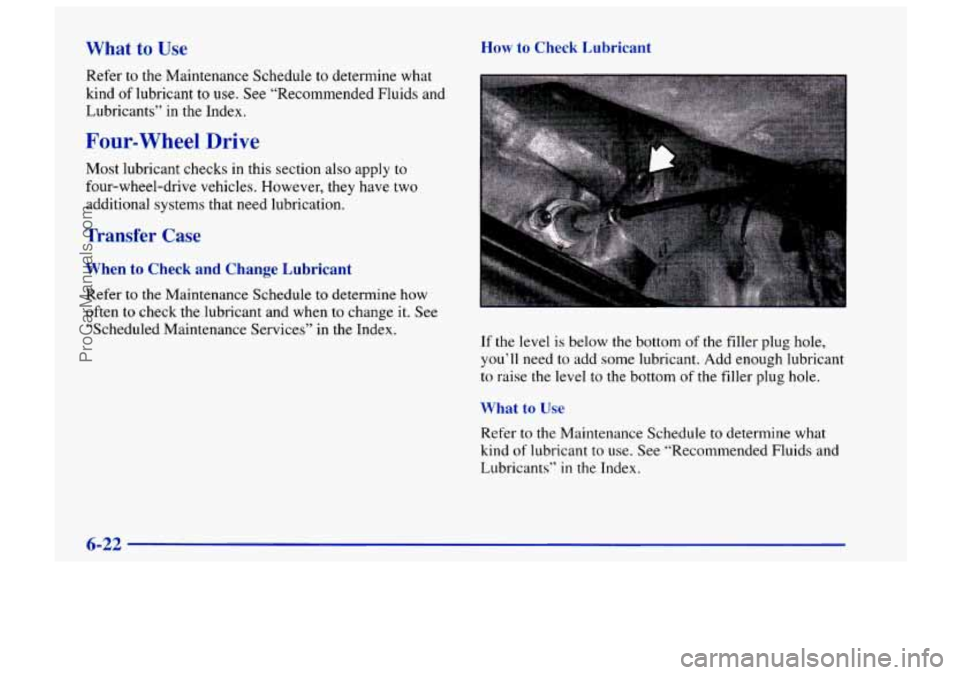
What to Use How to Check Lubricant
Refer to the Maintenance Schedule to determine what
kind of lubricant to use. See “Recommended Fluids and
Lubricants” in the Index.
Four-wheel Drive
Most lubricant checks in this section also apply to
four-wheel-drive vehicles. However, they have two additional systems that need lubrication.
Transfer Case
When to Check and Change Lubricant
Refer to the Maintenance Schedule to determine how
often to check the lubricant and when to change it. See
“Scheduled Maintenance Services’’
in the Index.
If the level is below the bottom of the filler plug hole,
you’ll need to add some lubricant. Add enough lubricant
to raise the level to the bottom
of the filler plug hole.
What to Use
Refer to the Maintenance Schedule to determine what
kind
of lubricant to use. See “Recommended Fluids and
Lubricants”
in the Index.
6-22
ProCarManuals.com